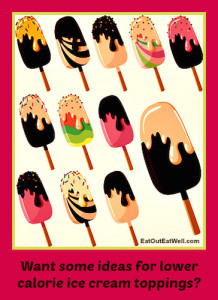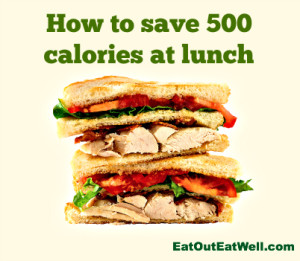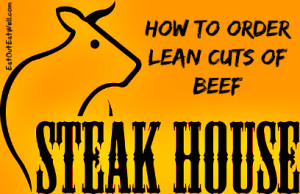
Is frozen yogurt actually healthy or are you being hoodwinked by “yogurt” in the name?
What’s In Frozen Yogurt?
Milk and milk by-products are the main ingredients in frozen yogurt.
Frozen yogurt companies have their own recipes, but most common frozen yogurts contain yogurt cultures, sweetener, corn syrup, milk solids, gelatin, flavoring, and coloring.
Sugar makes up 15-17% of frozen yogurt and adds flavor, body, and thickness. If you’re thinking healthy bacteria and frozen yogurt, you need to check the brand. Frozen yogurt isn’t regulated by the Food and Drug Administration — although it is by some states — and it may or may not contain live bacterial cultures.
Frozen yogurt is lower in fat than most ice creams because it’s made with milk instead of cream. Most of the nonfat “original” or “plain” flavors are usually the lowest in calories at about 30-35 calories per ounce with about 20g of sugar.
Frozen yogurt, which comes in a multitude of flavors, wears a healthy food “halo” but doesn’t always warrant one. Some brands and flavors are “healthier” than others — depending on the company’s recipe and the quality and quantity of ingredients which produce a product with varying levels of sweetness/tartness, fat content, consistency, and flavor. Of course, it’s up to you to gauge the “healthiness” of what and how much you add on top of your soft swirl!
Some Frozen Yogurt History
Frozen yogurt is relatively new – certainly compared to other frozen desserts. There is a tale, perhaps a myth, of Roman Emperor Nero (AD 54–68) sending his slaves into the mountains to get snow to mix with nectar, fruit pulp, and honey. Frozen yogurt, as we know it, was invented in Massachusetts in 1970 when a Hood dairy employee put regular yogurt through a soft-serve ice cream machine. The first “frogurt” cone was served by a Harvard Square store on February 3, 1971.
During the health craze of the 1980’s frozen yogurt went mainstream and then sort of fizzled. Its popularity rebounded when self-serve stores began allowing customers to control their portion size, mix and match flavors, pick from dozens of toppings, and pay by weight.
Calorie Tips
- Despite variation in recipes, frozen yogurts are fairly comparable when calories are compared. For instance, a half cup serving of Pinkberry has 116 calories, 0g fat and 20g of sugar; TCBY’s 98% fat free vanilla has 120 calories, 2g fat, and 17g of sugar; and Ben & Jerry’s vanilla frozen yogurt has 130 calories, 1.5g fat, and 16g of sugar.
- If you have a choice, choose soft serve rather than hard serve. Soft serve has air whipped into it making lighter in weight and lower in calories.
- Pick the smallest cup. When you start with a smaller cup rather than a large one, you’re already ahead of the game. Despite the fact that you swear you won’t fill up a large cup, you almost always do.
- Try putting the self-serve yogurt on top, not under, the toppings. Make space-filling low calorie fruit like berries or fresh pineapple your first layer. Then add things with crunch and volume, like cereal. Follow with the yogurt, then perhaps a teaspoon of candy crunch on top. Starting with yogurt often means putting a lot of yogurt in the cup followed by a lot of toppings. Layering low calorie volume food on the bottom can save you a lot of calories.
- Try not to mix flavors. Swirling a couple sounds like fun, but taste buds are funny. When you pick just one flavor and topping your taste buds are happy and you probably end up feeling more satisfied than if you have a variety of flavors.
Calories in Frozen Yogurt
One cup of low fat frozen yogurt runs about 210 calories. More specifically, for a one cup serving of different varieties of generic frozen yogurt:
- Frozen yogurt: Calories: 214; Fat: 2.94g; Carbs: 39.24g; Protein: 9.40g
- Nonfat frozen yogurt: Calories: 164; Fat: 0.65g; Carbs: 34.84g; Protein: 5.96g
- Low fat frozen yogurt: Calories: 214; Fat: 2.94g; Carbs: 39.24g; Protein: 9.40g
- Chocolate frozen yogurt (soft serve): Calories: 230 | Fat: 8.64 | Carbs: 35.86g; Protein: 5.76g
- Vanilla frozen yogurt (soft serve): Calories: 234; Fat: 8.06g; Carbs: 34.84g; Protein: 5.76g
- Frozen yogurt (non-chocolate flavors): Calories: 210; Fat: 2.70g; Carbs: 38.24g; Protein: 9.14g
- Chocolate frozen yogurt (not soft serve): Calories: 226; Fat: 3.90g; Carbs: 43.22g;Protein: 10.48g
- Frozen flavored yogurt (non-chocolate, not self serve): Calories: 221; Fat: 6.26g; Carbs: 37.58g; Protein: 5.22g
- Nonfat chocolate frozen yogurt: Calories: 172; Fat: 1.32g; Carbs: 35.19g; Protein: 8.95g
Some Frozen Yogurt Toppings
It’s easy to convince yourself that you’re really doing well (and you might be) by eating frozen yogurt instead of ice cream. But, some toppings can turn frozen yogurt into a caloric nightmare – especially when you keep piling them on.
Here are the calorie counts are for one ounce of various toppings:
Fruit (fresh and not):
- Strawberries: 9 calories
- Blueberries: 16 calories
- Blackberries: 12 calories
- Rasberries: 15 calories
- Pineapple: 17 calories
- Mango: 17 calories
- Grated sweetened coconut: 131 calories
Nuts:
- Slivered almonds: 170 calories
- Chopped peanuts: 166 calories
- Chopped walnuts: 184 calories
Cereals:
- Cap’n Crunch: 114 calories
- Cinnamon Toast Crunch: 123 calories
- Froot Loops: 97 calories
- Granola: 138 calories
Cookies/Pretzels/Candy:
- Oreo topping: 112 calories
- Pretzels covered in chocolate swirl: 130 calories
- Milk chocolate M&Ms: 146 calories (1/4 cup has 210 calories)
- Gummi bears: 90 calories (14 pieces have 120 calories)
- Nestle crunch bar topping: 37 calories
- Heath bar, crumbled: 170 calories
- Chocolate sprinkles: 25 calories
- Rainbow sprinkles: 30 calories





